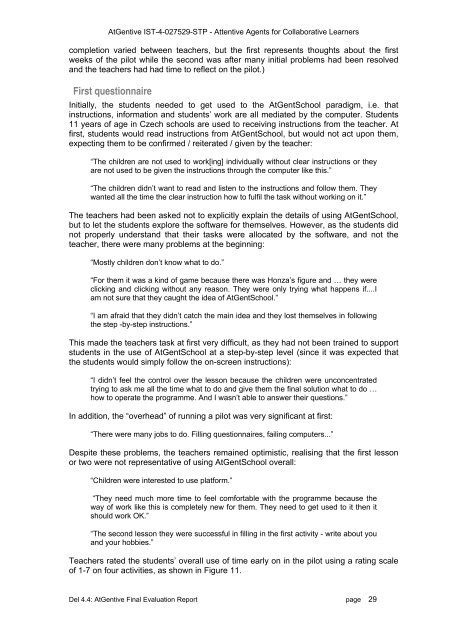Deliverable 4.4 - INSEAD CALT
Deliverable 4.4 - INSEAD CALT
Deliverable 4.4 - INSEAD CALT
You also want an ePaper? Increase the reach of your titles
YUMPU automatically turns print PDFs into web optimized ePapers that Google loves.
AtGentive IST-4-027529-STP - Attentive Agents for Collaborative Learnerscompletion varied between teachers, but the first represents thoughts about the firstweeks of the pilot while the second was after many initial problems had been resolvedand the teachers had had time to reflect on the pilot.)First questionnaireInitially, the students needed to get used to the AtGentSchool paradigm, i.e. thatinstructions, information and students’ work are all mediated by the computer. Students11 years of age in Czech schools are used to receiving instructions from the teacher. Atfirst, students would read instructions from AtGentSchool, but would not act upon them,expecting them to be confirmed / reiterated / given by the teacher:“The children are not used to work[ing] individually without clear instructions or theyare not used to be given the instructions through the computer like this.”“The children didn’t want to read and listen to the instructions and follow them. Theywanted all the time the clear instruction how to fulfil the task without working on it.”The teachers had been asked not to explicitly explain the details of using AtGentSchool,but to let the students explore the software for themselves. However, as the students didnot properly understand that their tasks were allocated by the software, and not theteacher, there were many problems at the beginning:“Mostly children don’t know what to do.”“For them it was a kind of game because there was Honza’s figure and … they wereclicking and clicking without any reason. They were only trying what happens if....Iam not sure that they caught the idea of AtGentSchool.”“I am afraid that they didn’t catch the main idea and they lost themselves in followingthe step -by-step instructions.”This made the teachers task at first very difficult, as they had not been trained to supportstudents in the use of AtGentSchool at a step-by-step level (since it was expected thatthe students would simply follow the on-screen instructions):“I didn’t feel the control over the lesson because the children were unconcentratedtrying to ask me all the time what to do and give them the final solution what to do …how to operate the programme. And I wasn’t able to answer their questions.”In addition, the “overhead” of running a pilot was very significant at first:“There were many jobs to do. Filling questionnaires, failing computers...”Despite these problems, the teachers remained optimistic, realising that the first lessonor two were not representative of using AtGentSchool overall:“Children were interested to use platform.”“They need much more time to feel comfortable with the programme because theway of work like this is completely new for them. They need to get used to it then itshould work OK.”“The second lesson they were successful in filling in the first activity - write about youand your hobbies.”Teachers rated the students’ overall use of time early on in the pilot using a rating scaleof 1-7 on four activities, as shown in Figure 11.Del <strong>4.4</strong>: AtGentive Final Evaluation Report page 29
















